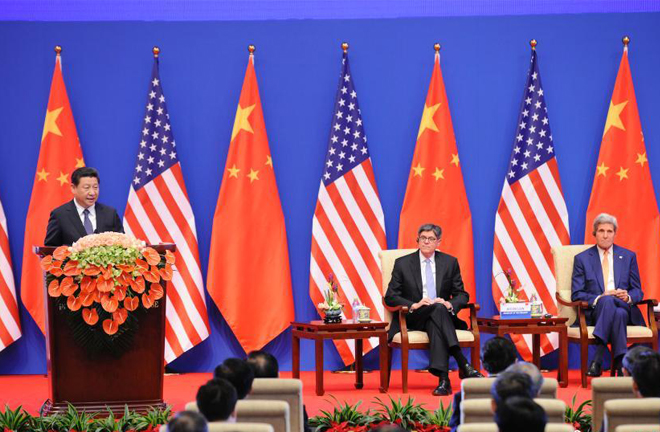China-US dialogues mark time of transition

Chinese President Xi Jinping delivers a speech at the eighth session of the China-US Strategic and Economic Dialogue that was held from June 6 to 7 in Beijing.
At the recently concluded high-level talks between China and the United States, delegations from each country discussed the ongoing transition taking place in bilateral relations while looking ahead to the G20 summit to be held in September in Hangzhou, capital of South China’s Zhejiang Province.
The eighth session of the China-US Strategic and Economic Dialogue was held together with the seventh round of the China-US High-Level Consultation on People-to-People Exchange from June 6 to 7 in Beijing. The mechanism involves the major departments and ministries from both sides and touches upon a broad range of topics.
The dialogue focused on how China and the United States can strengthen cooperation to tackle problems facing the world. The two countries built upon the consensus reached at previous meetings, reinforcing strategic communication and spurring mutually beneficial cooperation.
The talks also offered a platform for policy consultation between the world’s two largest economies ahead of the G20 Hangzhou Summit, which is scheduled to take place three months from now. China and the United States have set the agenda prior to the summit and promoted multilateral benefit via bilateral exchanges.
The upcoming G20 Hangzhou Summit will center on core challenges and prominent problems facing the world economy, and it will remain problem oriented. It will consist of four sections: innovative growth, global economic and financial governance, international trade and investment, and inclusive development.
Correspondingly, the macroeconomic situation and policy, open trade and investment, and financial stability and regulatory cooperation were under discussion during the strategic and economic dialogue.
The close alignment between the four sections for the Hangzhou summit and the three topics for the China-US talks is not coincidental. It reflects the eagerness of the two sides and the world to find solutions to common challenges as well as the global dividends the two largest economies will bring.
Moreover, the economic dialogue is the 10th since China and the United States launched the mechanism. It has played a unique role in enhancing strategic mutual trust between the two sides, expanding mutually beneficial cooperation and deepening the friendship.
By reflecting on developments in the last decade and planning ahead for the next 10 years, the dialogue has outlined a roadmap for the healthy, steady development of bilateral relations.
The dialogue is also the last one presided over by the Obama administration. Its transitional nature gives this session special significance.
The economic dialogue was concerned with building a new model of China-US major-country relationship and interaction between the two sides in the Asia-Pacific region. The strategic security talks were related to sovereignty security, military ties and maritime safety. And the high-level consultation on people-to-people exchange focused on intensifying institutionalized cooperation in multiple fields and innovating cooperation models.
In many areas, incremental measures were proposed, but other issues require long-term commitment. The success of the dialogue and consultation marks an important step toward the handover of China policy from the Obama administration to the next government.
The talks also were for “absorbing stress.” When previewing the event, Daniel Russel, assistant secretary of the Bureau of East Asian and Pacific Affairs at the US Department of State, said that the dialogue can help the two sides work through and absorb “stress” and “some shocks.” Frank dialogue can ease negative energy in bilateral ties, such as noise and distractions, and extending common interests can instill positive energy.
The key is to, based on respect for each other’s core interests and major concerns, actively seek to solve disputes through dialogue and consultation, or bring sensitive issues under control by constructive means, in order to prevent misunderstanding, misjudgment and conflict from escalating.
The 2016 China-US high-level dialogue has produced a substantive outcome list and contributed to progress in the new model of the China-US major-country relationship.
This article was translated from the Xinhua News Agency.

 PRINT
PRINT CLOSE
CLOSE